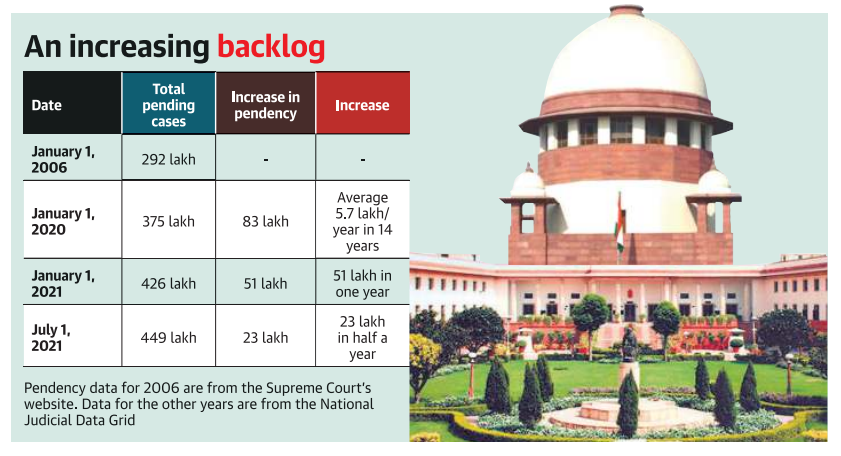[ad_1]
Context:
Recently, speaking at an event organised by the Karnataka Bar Council, Chief Justice of India quoted a former Chief Justice of the U.S. Supreme Court, Warren Burger, The notion that ordinary people want black robed judges, well-dressed lawyers in fine courtrooms as settings to resolve their disputes is incorrect.
People with problems, like people with pains, want relief and they want it as quickly and inexpensively as possible.
He made a plea to ‘Indianise’ courts to make them responsive to the needs of the Indian citizens.
Justice delivery system and mostly prisoners in undertrials:
- The Chief Justice of India has the historic opportunity to make this happen.
- At present, despite good intentions, the nation’s judiciary is hurtling towards a disaster and needs immediate attention.
- A measure of the justice delivery system is the pendency of cases in courts across the country. We have seen a significant deterioration in this aspect as shown in the table.
- More than 40% of cases are decided after three years in India, while in many other countries less than 1% of cases are decided after three years.
- If India does not act decisively and quickly, this percentage will keep increasing. The rich, the powerful and the wrongdoers have a field day by getting their cases expedited or delayed as they wish.
- The increase in corruption and crime is a direct fallout of the sluggish justice delivery system.
- This severely impacts the poor and marginalised. For them, the judicial process itself becomes a punishment.
- Data show that about 70% of prisoners in India are undertrials and are mostly poor citizens.
Filling vacancies: where the actual problem lies in?
Reduce the pendency of cases by filling sanctioned judicial positions. Analysis shows that between 2006 and 2019, the average increase in pendency was less than 2% per year whereas the average vacancy in sanctioned judicial positions was about 21%.
If the sanctioned positions had been filled, pendency of cases would have gone down each year.
- The nation neither needs 70,000 judges, as claimed by former Chief Justice of India T.S. Thakur, nor does it need to double the present number of judges. It needs to add about 20% of judges.
- This is in line with the sanctioned strength. This figure has been endorsed by Justice B.N. Srikrishna, Justice R.C. Chavan and 100 IIT alumni.
- The responsibility of selecting judges is largely with the judiciary itself. The responsibility of appointments in the subordinate judiciary lies with the State governments and their respective High Courts.
- The responsibility of ensuring near-zero vacancies should be with the Chief Justices of the High Courts and the Chief Justice of India and they should be held accountable for the same.
- Right now, nobody believes that they are accountable, and filling judicial vacancies is not considered a matter of priority.
- Filling all vacancies may result in a requirement of about 5,000 courtrooms. A simple solution would be to run 5,000 courts in two shifts.
Use of technology is the need of the hour:
To improve working with the use of technology, the e-Committee of the Supreme Court has been in existence since 2005.
It has made three outstanding recommendations which are not being followed.
- One, computer algorithms should decide on case listing, case allocation and adjournments with only a 5% override given to judges.
- It said all rational reasons and limits should be put on adjournments; case listing should give main weightage to ‘first in, first out’; and case allocation should take into account logical criteria.
- This would be a big step in reducing arbitrariness and the unfair advantage that the powerful enjoy.
- Two, the courts should focus on e-filing. The e-Committee made detailed Standard of Procedures on how petitions and affidavits can be filed and payment of fees can be done electronically without lawyers or litigants having to travel to the courts or use paper.
- This should be implemented in all seriousness and would also save about three lakh trees annually.
- Three, it focused on virtual hearings. COVID-19 prompted the courts to adopt virtual hearings.
- However, virtual hearings were held only in some cases while physical hearings were held in most. In pre-COVID-19 years, the increase in the pendency of cases in all courts used to be about 7 lakh cases a year.
- In 2020 alone, it increased to an astonishing 51 lakh. It appears that if a hybrid virtual hearing model is not adopted, the backlog of cases could cross 5 crore in 2022.
- The dysfunctional justice system will be perpetually overwhelmed.
Integrated Digital System in Indian Justice System:
- An effective justice system should be strong enough to ensure justice for everyone, irrespective of the economic condition of an individual.
- Implementation of an integrated digital system for the criminal justice system will help in speedy justice.
- It allows the interaction between various institutions through a digital platform. This system normalizes the format and content of data across all the systems.
- Thereby, it helps in smooth communication and avoiding duplication of data.
- This system will notify the registry about the defects in a particular appeal, un-rectified for an extended period.
- The system would also inform the accused that his lawyer was not pursuing his case carefully.
- The legal service authority would be informed of the case and the lawyer could be replaced. The system should monitor the quality of representation of the lawyer.
- After 14 years of imprisonment, the system would have notified the State government that the prisoner was eligible for re-sentencing of his sentence.
For implementing the recommendations: No change in laws needed:
All the recommendations:— e-filing of petitions, affidavits and payment of fees; algorithm-based computerised listing, roster, case allocation and adjournments with only a 5% override to be given to judges; hybrid virtual hearings; filling judicial vacancies; and holding Chief Justices responsible for ensuring that vacancies in judicial positions are less than 5% are based on the Supreme Court’s various decisions and the e-Committee’s recommendations.
These would require no changes in laws. At a conference, High Court Chief Justices and the Chief Justice of India and the government could make decisions on all of this.
Conclusion:
All the courts in the country must switch to a hybrid virtual mode immediately and start disposing cases.
Even after the COVID-19 crisis ends, it would be beneficial to continue hybrid virtual courts.
This will make access to justice easier for litigants, reduce costs, and also give a fair opportunity to young lawyers from small towns. The required hardware is available in all courts.
Priority must be given to speeding up the implementation of such a system. It will help in providing transparent, real-time access to criminal justice information to all stakeholders, including accused persons.
If all this is done, India’s judicial system can rank among the 10 top countries of the world.
These changes would make India the preferred nation for international investments and also fulfil the fundamental right to speedy justice of citizens.
[ad_2]


